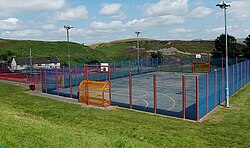A hardcourt (or hard court) is a surface or floor on which a sport is played. It is typically made of rigid materials such as asphalt or concrete. It may be covered with acrylic resins to seal the surface, while providing some cushioning and traction.[1][2] Hardwood surfaces may also be used in indoor settings.

Usage in Sports
editUse of hardcourt surfaces in street sports stems from the benefit of having clear, consistent, and durable surface to play on. Many urban and rural municipalities may see the maintenance of dirt lots and grass fields as burdensome and opt to build a hardcourt for community use.
Popular sports like Floor hockey, Hardcourt Bicycle Polo, Streetball, and Futsal are played on a broad range of styles of dry, flat floor surfaces such as a recreational parks, gymnasiums, or specialized courts.
The term hardcourt is heavily associated with tennis as the surface types has an outsized impact on the game. Tennis hard courts are made of synthetic/acrylic layers on top of a concrete or asphalt foundation and can vary in color. These courts tend to play medium-fast to fast because there is little energy absorption by the court, as with grass courts but unlike clay courts.[3] The ball tends to bounce high and players are able to apply many types of spin during play. Speed of rebound after tennis balls bounce on hard courts is determined by how much sand is in the synthetic/acrylic layer placed on top of the asphalt foundation. More sand will result in a slower bounce due to more friction, but in general hardcourts are setup to be faster then clay courts and slower then grass courts.[4][5][6]
Due to the balanced nature of hard courts compared to clay and grass courts, players with great all-around tennis skills such as Novak Djokovic tend to do well on them.[6]
Of the Grand Slam tournaments, the US Open and Australian Open currently use hard courts, and it is the predominant surface type used on the professional tour.[7][8]
Maintenance
editThere are numerous hardcourt maintenance methods which are commonly used to keep these facilities in top condition. Some of these include brushing, pressure washing with a cleaning solution and applying chemical treatments to prevent the growth of moss and algae. Anti-slip paint is also applied to hardcourts to give better playing qualities which enhance player safety and performance.[9] The largest issue faced by hardcourts is cracking due to shrinkage and settling. Post tension concrete may reduce this risk.[10]
See also
editReferences
edit- "Types of Tennis Courts". SportsByAPT. Advanced Polymer Technology. October 22, 2012. Archived from the original on May 8, 2019. Retrieved March 2, 2018.
- "What type of tennis courts are there and how do they influence the tennis player's game?". ertheo.com. Ertheo. July 17, 2017. Retrieved March 2, 2018. ...about cushioning...
- Newcomb, Tim (September 18, 2015). "WTA Finals in Singapore are played on unique wooden hard court surface". Sports Illustrated. Retrieved March 2, 2018. Possible wood comeback?
- Murray, Judy. "Hard courts take centre stage at the Australian Open and the US Open". BBC Sports. BBC. Retrieved March 2, 2018.
- "Different Types of Tennis Courts". CoachUp.com. CoachUp, Inc. August 1, 2016. Retrieved March 2, 2018. about sand in court to slow it down
- Newcomb, Tim (August 21, 2015). "The science behind creating the U.S. Open courts and signature colors". Sports Illustrated. Retrieved March 2, 2018. ...layered...cushioned...
- https://olympics.com/en/news/tennis-court-markings-dimensions-size-types-variety-surface-hard-grass-clay
- Reason, Leigh (April 30, 2005). "Comparison of Tennis Court Surfaces". Houston Chronicle. Hearst Newspapers, LLC. Retrieved March 2, 2018. ...Majors on Hardcourt...
- "Tennis Court Surface: Pros And Cons Of The Different Surfaces". OnlineTennisInstruction.com. Florian Meier & Partner GbR. Archived from the original on March 15, 2018. Retrieved March 2, 2018. ...In the United States Tennis is played primarily on hard courts....
- "Choosing a Tennis Surface". 10-s.com. 10-S Tennis Supply. Archived from the original on May 8, 2019. Retrieved March 2, 2018.
- "SportMaster tennis court surfaces". sportmaster.net. SportMaster Sport Surfaces. April 30, 2005. Retrieved March 2, 2018.
External links
edit- ^ Cite error: The named reference
ByAPT3was invoked but never defined (see the help page). - ^ Cite error: The named reference
ertheo3was invoked but never defined (see the help page). - ^ Cite error: The named reference
BBC3was invoked but never defined (see the help page). - ^ Cite error: The named reference
CoachUp3was invoked but never defined (see the help page). - ^ Cite error: The named reference
SI3was invoked but never defined (see the help page). - ^ a b Cite error: The named reference
:03was invoked but never defined (see the help page). - ^ Cite error: The named reference
Chron3was invoked but never defined (see the help page). - ^ Cite error: The named reference
OTI3was invoked but never defined (see the help page). - ^ Cite error: The named reference
10s3was invoked but never defined (see the help page). - ^ Group, The Valcourt (2022-10-27). "What Are Post-Tension Slabs & Why Are They Used? - Valcourt Building Services". www.valcourt.net. Retrieved 2024-08-20.
{{cite web}}:|last=has generic name (help)